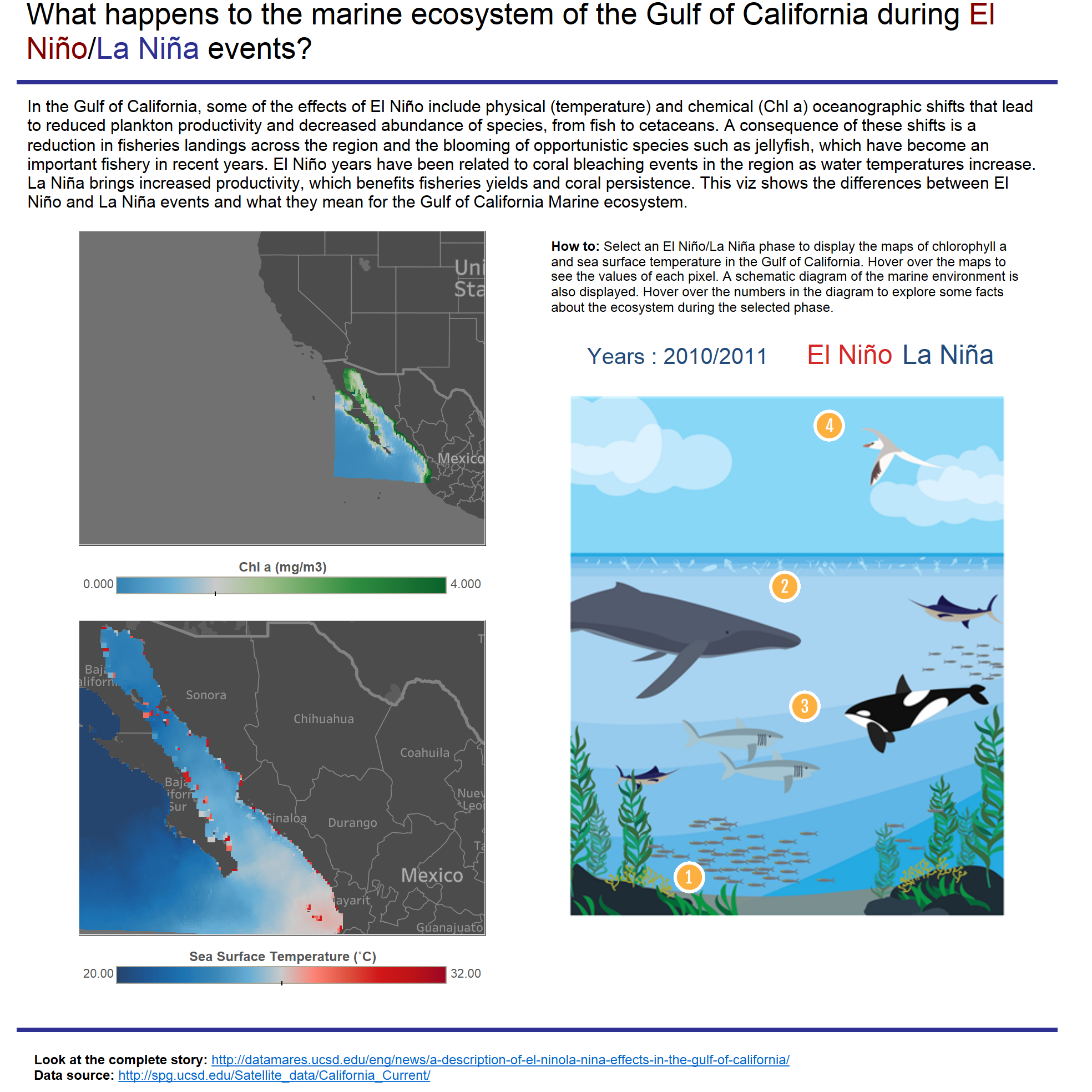Keywords:
A description of El Niño/La Niña effects in the Gulf of California.

The El Nino Southern Oscillation (ENSO) is an irregular, periodic variation in the sea surface temperature over the eastern tropical Pacific Ocean. It has two distinct phases. El Niño (the boy), which is characterized by the weakening of the equatorial winds, results in a warm phase in the eastern tropical Pacific that reduces the productivity of marine ecosystems all the way north to Alaska. Contrarily, La Niña (the girl) shows the reverse conditions and is characterized by the reinforcement of the equatorial winds, resulting in cooler and in general, more productive oceanic conditions. The oscillations between El Niño and La Niña occur approximately every 2-7 years, although the interval between each is somewhat irregular (NOAA 2016).
ENSO’s variations not only affect the ocean but also the atmospheric and terrestrial systems, with potentially significant societal and economic impacts. During El Niño years, some of these impacts include: 1) infrastructural damages to towns and cities generated by stronger and more frequent storms in the eastern Pacific; 2) reduced anchovy landings from the Peruvian coast (the largest biomass landed for a fishery on earth) as well as variations in other important commercial species in the whole eastern tropical Pacific (Ñiquen & Bouchon 2004); and 3) warmer and drier conditions in Central America, with repercussions for agriculture and water supplies (Dilley & Heyman 1995). In contrast, during La Niña conditions, the nutrient availability off the coast of Peru greatly increases, supporting larger populations of plankton, and thus increased anchovy and other fisheries landings in the region (Carr et al. 2002). The colder waters of La Niña also mean reductions in storm frequencies, although for some regions in Central America increased rainfall occurs causing the flooding of rivers in many parts of central and south America (Schöngart & Junk 2007).
The Gulf of California is not immune to the effects of El Niño/La Niña events. Here we use data generated by Mati Kahru from The Scripps Institution of Oceanography on chlorophyll a and sea surface temperature for El Niño (June 2015-today), as well as the last recorded La Niña event (March 2010-March 2011) to visually show what each climate phenomenon means for the waters of the Gulf of California. We use chlorophyll a as an indicator of productivity (amount of phytoplanktonic algae), which is the main source of food for all the food chain.
Main Findings
El Niño years bring low productivity to the Gulf of California and with this comes reduced fisheries productivity. One of the fisheries that shows a clear relationship between productive waters and landings is the sardine fishery operating off the coast of Sonora, Sinaloa, and Baja California. As a primary consumer in the food chain, a reduction in sardines results in declines in sea birds, marine mammals, and other big predators that rely on the sardines for food. Jellyfish blooms in the region may also be a result of strong El Niño conditions. La Niña brings the opposite conditions to the Gulf of California, with nutrient rich surface waters and an abundance of forage fish (such as sardines), and larger species that feed upon them.
Authors:
Alfredo Girón-Nava*, Andrew F Johnson*
Contact Information:
DOI:
10.13022/M35C7C
Affiliations:
Scripps Institution of Oceanography
Acknowledgements:
N/A
How to cite this story:
Alfredo Girón-Nava, Andrew F Johnson (2016): A description of El Niño/La Niña effects in the Gulf of California. DataMares. InteractiveResource. http://dx.doi.org/10.13022/M35C7C
References
2. Carr, M.-E. et al., 2002. Evolution of 1996–1999 La Niña and El Niño conditions off the western coast of South America: A remote sensing perspective. Journal of Geophysical Research, 107(C12), p.3236. Available at: http://doi.wiley.com/10.1029/2001JC001183.
3. Dilley, M. & Heyman, B.N., 1995. ENSO and disaster: droughts, floods and El Niño/Southern Oscillation warm events. Disasters, 19(3), pp.181–93. Available at: http://www.ncbi.nlm.nih.gov/pubmed/7552108.
4. Girón-Nava, A., López-Sagástegui, C. & Aburto-Oropeza, O., 2015. On the conditions of the 2012 cannonball jellyfish (Stomolophus meleagris) bloom in Golfo de Santa Clara: a fishery opportunity? Fisheries Management and Ecology, 22(3), pp.261–264. Available at: http://doi.wiley.com/10.1111/fme.12115.
5. Ñiquen, M. & Bouchon, M., 2004. Impact of El Niño events on pelagic fisheries in Peruvian waters. Deep-Sea Research Part II: Topical Studies in Oceanography, 51(6-9), pp.563–574.
6. Reyes, H., 2001. Effects of the 1997-1998 El Niño-Southern osccillation on coral communities of the Gulf of California, Mexico. Bulletin of Marine Science, 69(1), pp.251–266.
7. Richardson, A.J. et al., 2009. The jellyfish joyride: causes, consequences and management responses to a more gelatinous future. Trends in Ecology and Evolution, 24(March), pp.312–322.
8. Santamaria-del-Angel, E., Alvarez-Borrego, S. & Müller-Karger, F., 1994. The 1982-1984 El Niño in the Gulf of California as seen in coastal zone color scanner imagery. Journal of Geophysical Research, 99(C4), pp.7423–7431.
9. Schöngart, J. & Junk, W.J., 2007. Forecasting the flood-pulse in Central Amazonia by ENSO-indices. Journal of Hydrology, 335(1-2), pp.124–132.
10. Velarde, E. et al., 2015. Warm oceanographic anomalies and fishing pressure drive seabird nesting north. Science Advances, 1(5), pp.e1400210–e1400210. Available at: http://advances.sciencemag.org/cgi/doi/10.1126/sciadv.1400210.


